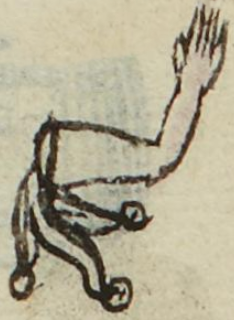Acolnauhacatl (MH820v)
This black-line drawing of the compound glyph for the personal name Acolnahuacatl or Acolnauhacatl is attested here as a man's name. This name starts with the root of shoulder (acolli), shown here as a right arm that is cut off at the shoulder, bent at the elbow, and has the hand raised. Below and slightly to the left of the arm is a spray of water, with three short streams and a droplet at the end of each one. Minimal lines of current and waviness in the water suggests movement. This is a phonetic indicator that the name starts with A-. Not shown visually is the part of the name that refers to 4-Reed (Nauhacatl, also spelled Nahuacatl). This part of the name derives from the religious divinatory calendar called the tonalpohualli. See below for two examples of glyphs for Nauhacatl or Nahuacatl.
Stephanie Wood
Acatl is a day name, and the companion number here, if shown, is four (nahui). Parents would often name a baby based upon the date of the birth in this calendar, and the child's fate was believed to be affected by what the calendar portended.
Stephanie Wood
1560
Jeff Haskett-Wood
nahuacatl, nauhacatl, hombros, agua, cuatro, caña, nombres de días, nombres de hombres, nombres famosos

acol(li), shoulder, https://nahuatl.wired-humanities.org/content/acolli
nahui, four, https://nahuatl.wired-humanities.org/content/nahui
aca(tl), reed or cane, https://nahuatl.wired-humanities.org/content/acatl
Nahuacatl, name of the sixth son of Tizocic, https://nahuatl.wired-humanities.org/content/nahuacatl
Hombro-Cuatro Caña, o Hombro-4-Caña
Stephanie Wood
Matrícula de Huexotzinco, folio 820v, World Digital Library, https://www.loc.gov/resource/gdcwdl.wdl_15282/?sp=715&st=image.
This manuscript is hosted by the Library of Congress and the World Digital Library; used here with the Creative Commons, “Attribution-NonCommercial-ShareAlike 3.0 License” (CC-BY-NC-SAq 3.0).



